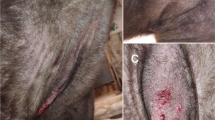Abstract
Purpose
Larval stages of trombiculid mites infest a wide variety of wild and domestic animals. The most common clinical signs related with the presence of these parasites are alopecia, crusts, erythema, excoriation, erosion, papules, pustules and vesicles. Most of trombiculid infestations may not be perceived by the clinician due to their small size. Although Ericotrombidium ibericense has been recorded on cats, it has not been found on dogs.
Methods
In August 2019, three domestic dogs presenting pruritic dermatological lesions in the ventral area of the body and interdigital spaces were presented at a veterinary clinic in Santarém, central Portugal. Trombiculid mites were extracted from the skin and preserved in 70% ethanol. Specimens were prepared in slides with Hoyer’s medium and observed with optical microscopy.
Results
After morphological examination of the specimens, mites were identified as E. ibericense (Acariformes: Trombiculidae).
Conclusions
Most of the trombiculids recorded in European clinical practice are generally identified as Neotrombicula autumnalis by default, since, in most cases, mites are not examined morphologically. This is the first record of E. ibericense in domestic dogs. More studies are needed to evaluate the distribution of these mites in Portugal. Veterinary clinicians must be aware of this parasitosis, as trombiculids can cause exuberant clinical signs, but are often misdiagnosed.





Similar content being viewed by others
References
Wharton GW, Fuller HS (1952) A manual of the chiggers. Mem Entomol Soc Wash 4:1–185
Stekolnikov AA, Bavani MM, Rafinejad J, Saboori A (2019) A new species of chigger mite (Acariformes: Trombiculidae: Leeuwenhoekiinae) collected from a scorpion in Iran. Int J Acarol 45:341–346
Mendoza-Roldan JA, Colella V, Lia RP, Nguyen VL, Barros-Battesti DM, Iatta R, Dantas-Torres F, Otranto D (2019) Borrelia burgdorferi (sensu lato) in ectoparasites and reptiles in southern Italy. Parasit Vectors 12:35
Mendoza-Roldan JA, Modry D, Otranto D (2020) Zoonotic parasites of reptiles: a crawling threat. Trends Parasitol. https://doi.org/10.1016/j.pt.2020.04.014
Tudor P, Fernoaga C, Tudor N (2015) Trombiculosis in cats due to Neotrombicula autumnalis (Acari: Trombiculidae) larvae: the first report in Romania. J Anim Plant Sci 25:1496–1498
Ramilo DW, Monteiro C, Carreira M, Pereira da Fonseca I, Cardoso L (2019) First report of Neotrombicula inopinata infestation in domestic cats from Portugal. Vet Parasitol 267:1–3
Schöler A, Maier WA, Kampen H (2006) Multiple environmental factor analysis in habitats of the harvest mite Neotrombicula autumnalis (Acari: Trombiculidae) suggests extraordinarily high euryoecious biology. Exp Appl Acarol 39:41–62
Santibáñez P, Palomar AM, Portillo A, Santibáñez A, Oteo JA (2015) The role of chiggers as human pathogens. In: Samie A (ed) An overview of tropical diseases. InTech, London, pp 173–202
Guarneri C, Chokoeva AA, Wollina U, Lotti T, Tchernev G (2017) Trombiculiasis: not only a matter of animals! Wien Med Wochenschr 167:70–73
Vercammen-Grandjean PH, Langston RL (1976) The Chigger mites of the World (Acarina: Trombiculidae et Leeuwenhoekiidae) Leptotrombidium complex. Section A. Section B. Section C, vol III. George Williams Hooper Foundation, San Francisco
Stekolnikov AA, Santibáñez P, Palomar AM, Oteo JA (2014) Neotrombicula inopinata (Acari: Trombiculidae)—a possible causative agent of trombiculiasis in Europe. Parasit Vectors 7:90
Stekolnikov AA, Waap H, Gomes J, Antunes T (2016) Chigger mites of the genus Ericotrombidium (Acariformes: Trombiculidae) attacking pets in Europe. Vet Parasitol 221:60–63
Hill PB, Lau P, Rybníček J (2007) Development of an owner-assessed scale to measure the severity of pruritus in dogs. Vet Dermatol 18:301–308
Stekolnikov AA (2018) Taxonomy and distribution of African chiggers (Acariformes, Trombiculidae). Eur J Taxon 395:1–233
Stekolnikov AA, Saboori A, Shamsi M, Hakimitabar M (2019) Chigger mites (Acariformes: Trombiculidae) of Iran. Zootaxa 4549:1–66
Fernández-Soto P, Pérez-Sánchez R, Encinas-Grandes A (2001) Molecular detection of Ehrlichia phagocytophila genogroup organisms in larvae of Neotrombicula autumnalis (Acari: Trombiculidae) captured in Spain. J Parasitol 87:1482–1483
Poliana T (2012) Trombiculidae harvest mites (Neotrombicula autumnalis) infestation in dog in winter season—a case report. Scientif Works C Series Vet Med 58:306–311
Areso-Apesteguía M, Areso-Portell JB, Halaihel-Kassab N, Garcia Salinas MJ (2019) Severe trombiculiasis in hunting dogs infested with Neotrombicula inopinata (Acari: Trombiculidae). J Med Entomol 56:1389–1394
Leone F, Di Bella A, Vercelli A, Cornegliani L (2013) Feline trombiculosis: a retrospective study in 72 cats. Vet Dermatol 24:535–e126
Seixas F, Travassos PJ, Pinto ML, Correia J, Pires MA (2006) Dermatitis in a dog induced by Straelensia cynotis: a case report and review of the literature. Vet Dermatol 17:81–84
Acknowledgements
We are grateful to the staff of São Francisco de Assis Veterinary Clinic who provided the specimens for our study. The authors also acknowledge Zoetis Portugal for the medicines (Simparica®) provided during this project. DWR holds the FCT post-doctoral grant SFRH/BPD/115202/2016.
Funding
This work was supported by CIISA - Centro de Investigação Interdisciplinar em Sanidade Animal, Project UIDP/CVT/00276/2020, funded by FCT, by Project UIDB/CVT/00772/2020, also funded by FCT, and by the Ministry of Science and Higher Education of the Russian Federation (project No. AAAA-A19-119020790133–6, to AAS).
Author information
Authors and Affiliations
Contributions
David W. Ramilo: conceptualization; data curation; formal analysis; investigation; methodology; writing, original draft. Pedro Costa: conceptualization; data curation; formal analysis; investigation; methodology; writing, original draft. Alexandr A. Stekolnikov: formal analysis; visualization; writing, review and editing. João Martinho Cláudio: data curation; formal analysis; investigation; methodology; resources. Ana Mafalda Lourenço: formal analysis; Isabel Pereira da Fonseca: supervision; writing, review and editing. Luís Cardoso: supervision; writing, review and editing.
Corresponding author
Ethics declarations
Conflict of interest
The authors declare no conflicts of interest.
Ethics approval
Not applicable.
Consent to participate
Not applicable.
Consent for publication
Not applicable.
Availability of data and material
All data obtained in the present work is available in the manuscript.
Code availability
Not applicable.
Additional information
Publisher's Note
Springer Nature remains neutral with regard to jurisdictional claims in published maps and institutional affiliations.
David W. Ramilo and Pedro Costa: Joint first authors.
Rights and permissions
About this article
Cite this article
Ramilo, D.W., Costa, P., Stekolnikov, A.A. et al. First report of Ericotrombidium ibericense in domestic dogs. Acta Parasit. 66, 253–258 (2021). https://doi.org/10.1007/s11686-020-00247-6
Received:
Accepted:
Published:
Issue Date:
DOI: https://doi.org/10.1007/s11686-020-00247-6




